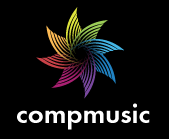First CompMusic Workshop at KIIT-Gurgaon
 |
First CompMusic Workshop: Computational Models for Music Information Research
|
Date: January 20th, 2012, from 9:30am to 5:30pm
Venue: Sir C. V. Raman Auditorium, College of Engineering, Kamrah International Institute of Technology, KIIT Campus, Sohna Road, Near Bhondsi, Gurgaon, Haryana, India
Chair: Xavier Serra, Universitat Pompeu Fabra (Barcelona, Spain)
This workshop was organized by CompMusic as a satellite event of FRSM 2012 with the aim to give an overview of the Music Information Research of relevance to Hindustani and Carnatic music. Attendance was free. Videos of the talks are available here.
Schedule:
- 09:30am: CompMusic: Current research issues and initial results (Xavier Serra) [video]
- 10:00am: Hindustani Music: A case for computational modeling (Preeti Rao) [video]
- 10:30am: Carnatic Music: A signal processing perspective (Hema Murthy) [video]
- 11:00am: tea
- 11:30am: Carnatic Music: A musicians perspective (T. M. Krishna) [video]
- 12:30pm: Hindustani Music: A musicians perspective (Pt. Buddhadev Dasgupta) [video]
- 01:30pm: lunch
- 02:30pm: Distribution based computational analysis of Makam Music (Bariş Bozkurt) [video]
- 03:30pm: Machine learning for music discovery (Joan Serrà) [video]
- 04:00pm: tea
- 04:30pm: Panel discussion (moderator: Xavier Serra; panelists: Preeti Rao, Hema Murthy, Bariş Bozkurt, T. M. Krishna, Mallika Banerjee) [video: part1, part2]
Abstracts of talks:
-
“CompMusic: Current research issues and initial results” [slides]. Xavier Serra, Universitat Pompeu Fabra (Barcelona, Spain)
This talk will present the research issues that have been identifyed and that are currently being worked on in the CompMusic project. Then it will discuss some of the initial results, particularly it will present the initial developments of the CompMusic browser. This browser will be the demonstrator of the technologies developed in the project, showing their potential for browsing culture specific music collections (currently working on Hindustani, Carnatic and Turkish-makam musics). -
“Hindustani Music: A case for computational modeling" [slides]. Preeti Rao, IIT-Bombay (Mumbai, India)
Classical music traditions around the world are characterized by well developed and systematically evolving grammars for melody, rhythm as well as the aesthetic aspects. All of these are grounded in the history, religion and culture of the civilization and therefore present valuable bases for various studies. While computational tools are growing rapidly, identifying clear cases of their utility to music and musicology is of interest. Apart from providing new perspectives altogether, computational methods can help musicologists to expand the scope of their existing analyses to very large datasets. Musicologists often work with scores (symbolic notation) which may be viewed as a highly reduced form. Audio processing technology can help to bridge the gap between performance practices and written forms. The value of this is particularly high in Indian classical music traditions due to the reliance on oral transmission of knowledge and the relative paucity of written documentation on music. Finally, the problems actually addressed by computational methods must be rooted in the tradition and whatever is considered relevant by the community. This talk will suggest problems in Hindustani music that lend themselves to computational analyses such as the distinguishing characteristics of different styles and exploring the relationship between compositions and improvisation. -
“Carnatic Music: A signal processing perspective” [slides]. Hema A Murthy, IIT-Madras (Chennai, India)
The purpose of this presentation is to understand Carnatic Music from a signal processing perspective. The field is rather nascent and there is hardly any meaningful literature on the same. In this talk, we will discuss different tasks that can be attempted using signal processing. The tasks include (i) identification of the form of a piece (ii) segmenting a piece into different parts, namely, alaap, kriti, neraval, kalpanaswarams, tani avarthanam (iii) identifying the different types of gamakaas used by a musician in a piece (iv) identifying the singing voice, the accompanists from the audio, (v) identifying the bols in the percussion solo (tani). -
“Distribution based computational analysis of makam music” [slides]. Bariş Bozkurt, Bahcesehir Unviversity (Istanbul, Turkey)
A review of existing literature on computational analysis of makam music shows that almost all methods base on some study of pitch distributions (computed either on symbolic data or audio data). The talk will first review such approaches and present tools developed for automatic tuning analysis, makam recognition, tonic detection based on audio data. Following the review, it will address further potentials and the limitations of distribution based analysis for studying makam music. -
“Machine learning for music discovery” [slides]. Joan Serrà, IIIA-CSIC (Barcelona, Spain)
This talk will overview typical machine learning approaches to the supervised labeling of music excerpts (also known as category-based grouping). It will concentrate on the query-by-example paradigm and on three major steps: audio feature extraction, feature selection, and document classification. Furthermore, in the last part of the talk it will discuss several basic but important issues to be considered when developing a supervised approach to music labeling.
Panel discussion:
The major goal of the panel discussion is to gather ideas for problems to be worked in CompMusic for the particular case of Carnatic and Hundistani music. Engineering research requires to start with formalized concepts that can yield to computational processing, and that is quite difficult in an artistic field like music. In the panel we will try to focus on the differences between Carnatic and Hindustani musics in terms of intonation (tuning), melodic and motivic organization, and rhythmic patterns. Some ideas for the panel discussion include: (a) differences between tabla and mridangam in terms of rhythmic playing. (b) Iiprovisation styles based on melodic signatures, phrases, ... in both Hindustani and Carnatic musics. (c) Gamakas in Carnatic music versus meends/gamakaas in Hindustani music. (d) characterization of Gharanas in Hindustani music in terms of intonation, melody, and rhythm. Types of singing Khayal vs. Drupap.



